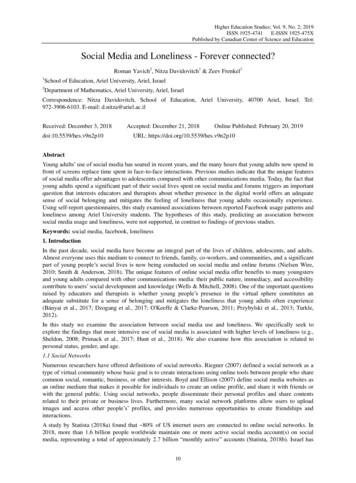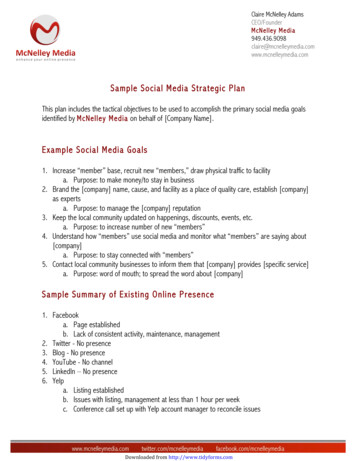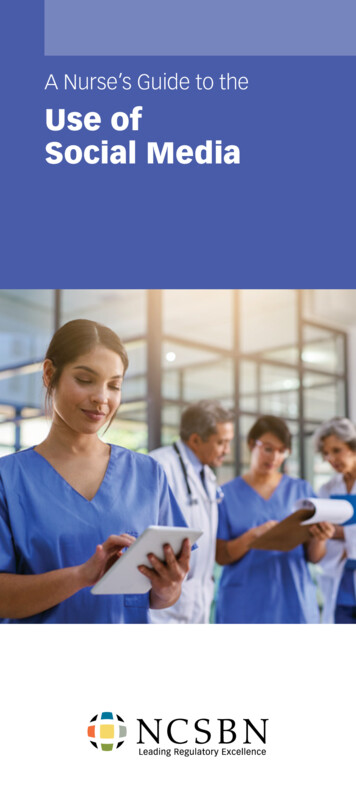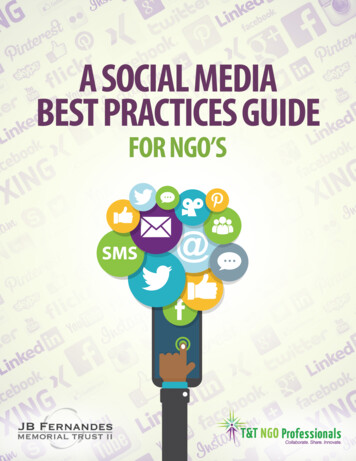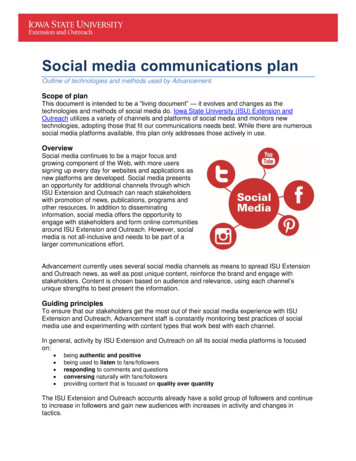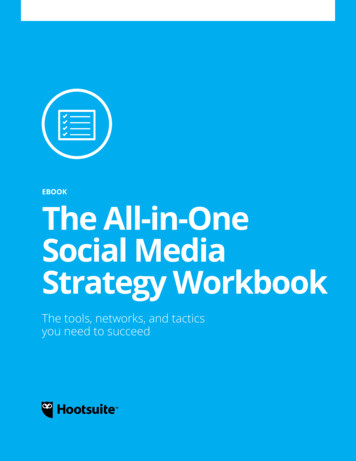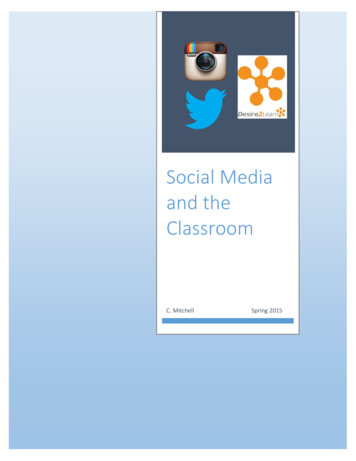
Transcription
0Social Mediaand theClassroomC. MitchellSpring 2015
1Table of ContentsExplanation of Project:2ContextStudent Learning Outcomes and Course RequirementsQuestionMethod of InvestigationProject Activities (Description, Results, Specific Student Response and Analysis):3Preliminary ResearchDevelopment of SNS AccountsStudents’ Semester Assignments: Live Tweet, Submissions, PostsInstructor Posts: Examples, Related Materials, HomeworkComplete Student Feedback:10Survey ResultsStudent uggestions for improvementAppendix:Preliminary Student SurveyDesire2Learn homepageInstagram homepageTwitter homepageStudent PostsInstructor Posts16
2Explanation of Project:Context:With the increasing role of technology in our daily lives, there is a push to include technologyin the classroom. At Los Medanos College, technology has been formally implemented into coursesthrough Desire2Learn. This program allows instructors to post lectures, grades, readings, exercises,among other materials. While this platform provides students with valuable information, it is difficultfor students to take full advantage of the site through their mobile devices, devices that are sometimesstudents’ primary method of accessing the internet. Moreover, given that nearly all students have cellphones capable of connecting to the internet, there is much potential for integrating technology into theclassroom through students’ use of their smart phones. Free applications like Twitter and Instagram,with their mobile-friendly interface and profile features, may be an alternative way for students to haveeasy access to course materials.Moreover, the popularity of these sites may increase students’ interest with the course materialssince they can be accessed from a “fun” platform. There appears to be great potential for increasingstudent engagement through the use of social network sites. By increasing students’ engagement,students will be more likely to master the Student Learning Outcomes. At the developmental-level,students are often uncomfortable with the classroom and by providing students with the opportunity toconnect to material through a familiar and convenient application, like a social network site (SNS),students will gain a sense of comfort and a level of confidence in the classroom, which will translateinto greater success when working to meet SLO’s.Student Learning Outcomes and Course Content Requirements:1. Read actively and demonstrate critical thinking skills through the ability to summarize, analyze,evaluate and synthesize assigned readings. (PSLO 1,2,3)2.Write, edit and revise expository essays which synthesize course readings and are clearly focused,fully developed, and logically organized. Compose essays with sentences which display adeveloping syntactical maturity and whose meaning is not impaired by excessive grammar, usageand proofreading errors. (PSLO 1,4)3.Demonstrate the ability to use strategies for academic success, including use of college resourcesand ability to monitor and evaluate one’s own learning. (PSLO 1,5)“It is the intent of the department that English 90 be a course that engages students and speaks to theirissues and concerns.” (Course Content)Research Question:Can utilizing social media in the classroom improve student engagement with course materialsand in the process improve student success with student learning outcomes? Can students learn to“monitoring and evaluating their learning” by reflecting on the integration of social media into theclassroom?
3Methods of Investigation:First, I gave students a survey, asking them to share their views on integrating social networksites into the course. After reviewing students’ feedback, I created a course-specific Instagram accountand a course-specific Twitter account. I linked these accounts with the course Desire2Learn (D2L)webpage so that students could choose to use D2L, Twitter, or Instagram to access material. By linkingthe accounts, no one was required to create or use a SNS account if they did not want to do so.Throughout the semester, I looked to use technology to engage students with course materialthrough a variety of ways. First, I offered students the option to complete some homework assignmentsusing SNSs. Additionally, students had the option to submit classwork through SNSs. Students werealso asked to respond to questions by either posting to D2L or Instagram. I also posted supplementarymaterial to SNSs to further engage students. I posted homework and examples to Instagram, and Iposted or retweeted supplementary materials to Twitter.As part of the English 90 SLO’s, students are expected to “demonstrate the ability to usestrategies for academic success” as well as “monitor and evaluate” their learning. After integratingSNSs into the course, I asked students to reflect on and identify their strategies and preferences foraccessing the information. By giving students options for utilizing SNSs or D2L, I allowed students todetermine the method that would best support their learning. Through class conversations and writtenreflections regarding the integration of SNSs, students “monitored and evaluated” learning and appliedstrategies for academic success.Project Activities:Description of Preliminary Research:At the beginning of the project, I gave students a preliminary survey that gauged interest inintegrating SNSs into the classroom. I asked students if they had SNS accounts and if they would beinterested in using them for school work.Results and Analysis:Of the 25 students who took the preliminary survey, 23 had some sort of SNS account. Out ofthe 25 students, 15 students specifically commented that they would be interested and excited to useSNSs for class. Most students said that they already use SNSs, so it would be easy for them to integratecourse materials. Some students specifically pointed to an increased interest in the material. Onestudent explained, “I feel that students will be more engaged in the class because these are the thingswe find to be appealing and entertaining.” Another student commented, “I like D2L, but if you postedthe readings on a social media site, I feel I would be more interested in reading it.” Finally, anotherstudent said that “incorporating social media sites into classes and our homework would be great. Wealready use social media almost daily.” Through this survey and our subsequent conversations aboutthe use of D2L and SNSs, students were reflecting on their learning and the ways that learning canhappen through a variety of ways, including social media. Moreover, students specifically pointed tothe fact that utilizing SNSs will increase their interest and engagement with the material.Two students did not have SNSs accounts, but one said she would be interested in creating anaccount for the course. The other student was concerned about getting distracted online. He noted, “Ibelieve using a social media account for homework would really distract me from my primary
4purpose.” Other students, even those who were excited about using SNSs in the classroom, expressedconcern about getting distracted. One student said, “I might end up doing or looking at somethingelse.” Another added that “the downside might just be getting distracted.” In our class discussion,students highlighted the potential to get distracted but argued that it would be best to provide studentswith an option to use either D2L or SNSs so that they could choose the platform that worked best forthem. By reflecting on the potential to get distracted, students monitored their learning.Four students who had SNS accounts noted that they preferred to use D2L for homework. Thefour students had a variety of reasons for wanting to keep D2L as the primary resource for accessingmaterials outside of class. One student explained that she was not familiar with SNSs and she wasalready familiar with D2L, and another noted that she preferred to use SNSs for fun and didn’t want tointegrate school into this activity. By giving students a choice, I was able to accommodate all studentsand provide a variety of ways to engage students with materials while providing students a chance toreflect on the method that would best serve them.Development of SNSs Accounts:After our conversation, I opened a Twitter account, but most students asked me to create anInstagram account instead. I opened an Instagram account and linked it to the Twitter account and toour course Desire2Learn webpage as a “newsfeed.” Throughout the semester, I posted the homeworkassignments and examples to Instagram. I retweeted and posted links to the Twitter account. Since theaccounts were linked, I only had to post to one account and students only had to check one platform(either Twitter, Instagram or D2L) for course information, and they could choose whichever platformthat they preferred. Giving students a choice allowed them to determine the best strategy for theirsuccess.Results and Analysis:At first, I was posting the homework and materials to D2L, Twitter, and Instagram separately.It proved to be too much work for me since I had to login and post materials multiple times. Posting toInstagram can take some time, occasionally up to 10 minutes, because it requires taking and editing aphoto. After combining the platforms, I was able to effectively reach every student in the class in ashorter amount of time.I made a point of explaining that students were in no way obligated to create or make accounts.Whenever I discussed postings in the classroom, I always made sure to provide student examples fromD2L and from SNSs. I did not want students to feel obligated to get a SNS account, and I did not wantthe project to lead to discussions on how to post or comment using SNSs. Instead, I wanted toencourage students to access materials in a way that best appealed to their learning styles and interests.By allowing students to make a choice, students reflected on their learning strategies. They evaluatedeach strategy to determine which would best enable them to achieve academic success. In ourdiscussions, students monitored their learning and identified their strategies for engaging with thematerial outside of the classroom.
5FollowersPercentage of ClassStudents with accounts butnot following classInstagram1560% (75%)Twitter1352% (65%)42Either1768% (85%)Both1144% (55%)25 students in the course(20 regularly attending)Description of Student Assignments:After getting students’ feedback about their interest in developing SNS accounts, I offeredstudents the opportunity to complete assignments using SNSs.Early in the first unit, we were reviewing reading strategies for “reading actively” (SLO 1). Forone reading, I gave students the option of handwriting their PPPC or live-tweeting their notes. In theprocess of deciding which method to take, students applied strategies for learning.As the semester progressed, students were also given the option to submit homework via SNSs.Students were tasked with brainstorming ideas and a focus for their Unit 2 essay on the AmericanDream and their Unit 4 essay on Bless Me, Ultima (BMU) in line with SLO 2. By posting ideas online,students were sharing their focus and brainstorming ideas for their papers. Other times, students wererequired to post comments or ideas on either Instagram photos or to D2L. Students were asked to postan example of a noun appositive and to offer suggestions for how to correct a concession sentence.These assignments helped students develop syntactical maturity.Throughout the semester students were asked to submit classwork by taking a picture andsending it to me via email or SNSs. These classwork activities were often hands-on, interactiveactivities that were completed in small groups. Most activities were associated with SLO 1,challenging students to read actively and take notes on an article and then complete a summary. Otheractivities were in line with SLO 2, asking students to develop outlines in order to write “clearlyorganized” essays. By having students submit the homework via technology, students could easilydocument and share their classwork with classmates.Results:HomeworkAssignmentLive tweetAmericanDream postBMUcharacteristicsBMU 387%38%33401067%60%Avg*: 93%Avg*: 51*excludes live-tweet assignmentCompletion%110%SNS %1%
6Throughout the semester, an average of 15 students (out of 20; 75%) completed the homework.In general, completion rates were below average (14 students) for assignments that required students topost on D2L or on SNSs. Of those 14 students, half posted on SNSs.Classwork Assignmentoutline-- summary*essay outlinetopic sentence outlineInstagram Twitter Email Total142731152215SNS %71%80%80%*the top “liked” academic post on Instagram is a post of our classwork.Student Response:With the live-tweet assignment, students gave many reasons for choosing to complete the notesin a traditional way. Students explained that they did not want to post classwork on their personalTwitter homepages because they did not want to lose followers or have their friends see theirschoolwork. They didn’t mind posting or commenting publically on the course accounts, but they didnot want their work to appear on their own pages. Other students noted that they felt like it was moreof a challenge to live-tweet. In the process of tweeting, students were limited to 140 characters, sostudents had to think very carefully about wording and content. One student noted that he tried theexercise, but he found that he would type something and have to erase it and retype it in order tocondense the information. In the process of completing the assignment, the student monitored hiscomprehension and ultimately decided to apply an alternative strategy.Students who used SNSs to turn in assignments cited the convenience and ease of submittingmaterials. They had constant, easy access to the account and could submit homework instantly byusing their phones. Students felt like it was quicker to use SNSs instead of taking the time to log intoD2L to complete homework or write out the information on a hard copy. Others also pointed to SNSsspecific features, like hashtags, which allowed them to easily find the classwork and review it later.Finally, other students specifically noted that they enjoyed getting to use their phones in class.In contrast, students who chose to submit assignments through D2L gave two primary reasonsfor posting to D2L. Some students said that they don’t have SNS accounts or don’t use them often.Other students felt more comfortable using D2L because it is school-sanctioned.Additionally, students specifically commented that looking at each other’s examples online wasbeneficial. They stated that by posting or submitting homework publically through D2L or SNSs, theyhad access to their classmates’ ideas and additional examples. Students felt that reviewing each other’sexamples and ideas helped them to improve their own work. In the survey, 94% cited that they lookedat classwork examples online. Out of 19 students, 63% said that they read others’ homework posts onSNSs, and 73% read others’ homework posts on D2L. While only 75% of students completedhomework, 90% said that they reviewed class examples.Analysis:Throughout the semester, students reflected on the multiple options for accessing courseinformation, and they utilized the method that they felt best suited their learning. By either submittinghomework through SNSs or D2L, students determined the advantages and disadvantages of each andreflected on their resources.
7Although students pointed to the challenge of live-tweeting—keeping it to 140 characters—as anegative, I saw this as an incredible learning opportunity. There is potential for students to learn to“read actively” and to “summarize” in line with SLO 1 through a live-tweet assignment. If notnecessarily an activity that requires students to tweet, I think that the live-tweeting process couldprovide students with a framework for approaching the note-taking process by detailing for them howto read actively and annotate in a clear, concise way. I think that by revising the assignment, theactivity could be adapted to the classroom to teach students how to take concise notes and how tosummarize.While students recognized the benefit of reviewing others’ examples online, students did notnecessarily want to post themselves. Completion rates dropped for online postings. It is possible that,for some students, posting online is more challenging than completing assignments in traditional ways.While some students noted the ease of submitting homework through SNSs, posting on D2L can beextra work as students have to use a computer and have to go through a login process to access D2L.Even when students had access to the internet through the computer lab, some did not post.On the other hand, low completion rates may also indicate a lack of confidence. One studentspecifically noted “It made me nervous to post things I wasn’t sure of, but I felt involved with theinteractions.” The student both acknowledges a sense of insecurity, but she also highlights the potentialfor these sites to build community and further engage students. The student’s comment is particularlyinsightful because it highlights both the potential to encourage participation but also the importance ofensuring that students feel confident in their skills. For the noun appositive and BMU themesassignments, participation was lowest. Both assignments asked students to post examples afterpracticing in class. It is more likely that most students did not feel confident enough in their skills towant to publically post their work. In comparison, with the American Dream post, students were askedto provide a definition or image of the American Dream. Since there really was no wrong answer,students were more willing to post responses publically. These results indicate that I should take morecare to ensure that students feel confident in their knowledge when I ask them to post online. Bybuilding community in the classroom, I can increase students’ engagement and mastery of skills andalso their willingness to share their knowledge.Although participation was lower with some of the online posts, in general, students noted thatthey enjoyed looking at the examples online. Given that more than half of the class took time to reviewthe homework posts outside of class is further significant. We discussed these public posts at length inthe classroom, but I did not require students to review examples. Students applied strategies foracademic success and monitored their own learning when reviewing the examples. They recognizedthe potential for improving their knowledge and they took action to apply strategies for improving theiracademic performance. With so many students interested and excited to look at examples, it is clearthat it is important to continue to have students post materials online and to post classwork. However, Iwill need to make adjustments to ease students’ anxiety and to boost students’ confidence in order toboost student participation. Additionally, I may have to set aside more class time to further motivatestudents to post.
8Description of Instructor Posts:In addition to having students post materials using SNSs, I used SNSs to post information andmaterials throughout the semester. I posted examples, detailed handouts, and notes from the class.While I use D2L to post supplemental materials, I did not generally share examples or class notes.SNSs made it easy to provide this additional material because it was just a matter of taking a picture.These posts proved to be the best way to increase student engagement with the material.With the convenience of Twitter, I would occasionally post or retweet relevant materials. Thematerials were connected to our class conversations and unit discussions, but I did not require studentsto review them. For example, we read a poem by Walt Whitman, and I tweeted a link to a recent Levi’scommercial that included a Whitman poem. I also retweeted relevant articles. I tweeted or retweetedsupplemental information about 2-3 times per unit. Given that these materials were not required for thecourse, I did not want post them directly to D2L under the “Course Content” section. By posting anarticle on D2L, it gives students the sense that it is a part of the required reading materials. With SNSs,I could easily retweet a link or post a photo and clearly convey the fact that the material wassupplementary.In my past courses, I would review the homework verbally, write it on the white board, andthen post the assignments on Desire2Learn inthe “News” section. This semester, I reviewedthe homework verbally, wrote it on the whiteboard, and posted a photo to Instagram with acaption explaining the assignment. Withtraditional D2L posts, I would type out theassignment, but I would only occasionallyupload a file of a reading or handout. WithInstagram, I posted a photo of the readings andrelevant handouts along with the assignment sothat students not only had the writteninstructions but they also had a visual of thespecific materials to use. The Instagram wasconnected to Twitter and linked to theDesire2Learn homepage, so students hadaccess to the homework posts via Instagram,Twitter, or Desire2LearnResults*:Total number of posts: 76Likes: 119Followers: 13*Data collected after the drop deadlineStudent Response:Again, students noted that they were excited to review additional examples of the materials. Ithelped to clear up questions and provide ideas for building essays. Students also stated that it helpedthem get a sense of the requirements and expectations.
9With the supplementary material, in general students did not review the retweeted links. Of the18 that responded, 55% reported that they did not read them and 22% marked “N/A.” However, 22%said that they sometimes reviewed the material.For the homework posts, student response was overwhelmingly positive. Both the students whoused Instagram and the students who used D2L for checking the homework assignments found that thepictures added clarity and increased their ability to successfully complete the assignments. Whenasked, 80% of students responded that they liked having a visual to accompany the homeworkassignment. Specifically, students commented that they liked SNSs because “it has pictures,” and onestudent explained: “I liked seeing the pictures accompanying posts so I had a visual.” Another studentcommented that she “does better when she is visually learning.” In general, students noted that thebiggest advantage to integrating SNSs into the classroom is the fact that it made the homework moreinteresting to review while clearly detailing the assignment.Analysis:In the past, I would only post a few supplementary examples on D2L. I was hesitant to post toomany examples on D2L because I was concerned that students would be tempted to copy the material.However, by using SNSs, I was able to crop or limit material in a way that gave students ideas of theexpectations and examples, but the information was not so complete that I needed to worry aboutplagiarism. Given students’ positive response, I plan to continue to post similar material using thismethod next semester.While most students did not look at the supplementary material, given that it was optional, I amexcited to see that 22% of students sometimes clicked on the links. This shows that a few studentswere connecting with the material outside of the context of the classroom. Even when students did notclick on the articles, the process modeled for students how to identify connections in their daily lives. Iobserved that this semester more students reached out to me to discuss personal connections to thecourse material. In the past, usually one student a semester (on average) would send an email with alink to a related article. This semester, however, I had six students email, tweet, or simply show mematerials and images on their phone from SNSs that connected to our class material. I think that bymodeling this connection through retweeted links and related posts, students felt more confident intheir ability to identify connections and felt empowered to share those connections. When students seeconnections to their own lives, they are more engaged with the course content and can better meetStudent Learning Outcomes. I plan to increase the number of posts next semester to further modelmaking personal connections to course content.Posting images with the homework turned out to be the most significant aspect of the project.Initially, I expected the focus of the project to be students’ posting through SNSs. As the projectprogressed, I learned that most students did not mind the traditional methods of completingassignments, but students were incredibly interested in the way that SNSs could be used to deliverexamples and homework assignments. In the student survey and throughout the semester, studentscommented that seeing a visual of the specific materials that were needed to complete the homeworkhelped them gain a better understanding of the assignments. D2L can be a rather clinical platform. Incomparison, Instagram, with its filters and editing options, is inviting and aesthetically pleasing,making it all the more interesting for students to review. Additionally, I observed when students had a
10visual of the handout and the assignment, there was less confusion and fewer students emailedquestions asking for clarification.I also saw that students were thinking about the homework more often when they checked it onSNSs. I posted the homework within a few hours of the end of class. Soon after I had posted thehomework on SNSs, students would “like” or “favorite” the post. Then, later, students would again“like” or “favorite” posts as the deadline for homework approached. Instead of reviewing thehomework just once, when they logged onto D2L to complete the assignment, students saw each postin their SNSs feed and then returned to it view it later when they planned to complete it. Studentsreviewed the material more times when they viewed it on SNSs, demonstrating their engagement.Students’ specific comments and feedback provide a clear example of the way that they haveevaluated their learning style and learning process. By recognizing the fact that adding a visual helpedthem accomplish the homework, students tracked their learning process. They were monitoring themethods that work best for them and were applying strategies to increase their academic success. I planto continue to post homework assignments to Instagram because the visual element increasedengagement and added clarity by appealing to visual learners.Complete Student Feedback:Results:Submitting homework:StatementSubmitting work via SNSs was easyDisagree1Somewhat disagree2Somewhat agree8Agree7N/A1Total Response19304267612102021I preferred submitting work viaSNSsI liked looking at others' examplesSubmitting Classwork:StatementSubmitting classwork viaSNSs was easyI preferred submitting workvia technologyCommenting/Posting:Disagree3Somewhat disagree4Somewhat agree3Agree5N/A1Total Response1614410019
11StatementI liked posting to SNSsDisagree3Somewhat disagree2Somewhat agree5Agree6N/A3Total Response19330131417101010110191818StatementI checked D2L for homeworkNever2Sometimes1Often15Total Response18I checked SNSs for homework46919StatementI checked out retweeted linksI liked having a visual with thehomeworkDisagree10Somewhat disagree0Somewhat agree4Agree0N/A4Total Response1813313020I read others' posts on D2LI read others' posts on SNSsI liked looking at others'examplesInstructor Posts:Comments:What I liked best about submitting homework through SNSs:Convenience:It’s at your hand/quick/easyInstagram was easy and done fast.It was easy and convenient for meThe ease of accessing and turning in assignmentsIt was always easy to go back and look at the examples or work we were supposed to doWhat I liked about submitting homework through SNS is that it was very quick and accessible.Was how fast and easy it was. Very efficient.Helpful:It helped me to recap on previous assignments and things we talked about in class.Also the use of visual media with coursework was helpfulI believed it was helpful because it did give you the opportunity to view your classmates’ ideas as well.Interesting:I just enjoy technology so being able to use my laptop makes doing homework a tad fun.I didn’t submit homework through SNSs because:Don’t have/use SNS:I barely use my SNSsI don’t have an Instagram or Twitter accountNot professional:I don’t want to use my private Instagram to do homework.I preferred D2L because it felt more conventional that it was designed for academic purposesWhat I liked best about submitting classwork through SNSs:Convenience:The ease and ability to incorporate media into course workIt gives easier access with what we do on a regular basis.I like how fast I can submit because of how I’m already logged in and I know SNS very well.Easy navigation through SNS and the classwork was organized in some way through hashtagsLooking at examples:I can use other people’s work as examplesI can look at others examples that helps me get ideas for homework.This also gave you ideas for essays and the views of others opinionsHaving class discussions availableInteresting:It was fun talking about it and doing it in classI could use my phone during class and post things like I’d post anything else.What I liked best about posting a comment to Instagram:Convenience:
12I could find it easily if I needed it.I liked how the picture is a set theme so it’s easy to talk and comment onEngagement:People can agree or disagree with what you’re sayingIt connected me with classmates and Instagram always
Dream and their Unit 4 essay on Bless Me, Ultima (BMU) in line with SLO 2. By posting ideas online, students were sharing their focus and brainstorming ideas for their papers. Other times, students were required to post comments or ideas on eithe





